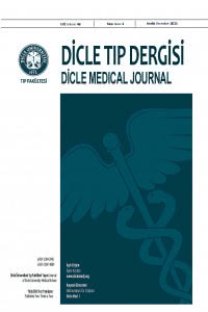The Effect of Health Problems at Birth on Breastfeeding: A Cross-Sectional Study in a Third Step Hospital
Doğumda Sağlık Problemlerinin Anne Sütü Emme Üzerine Etkileri: 3.basamak Bir Hastaneden Kesitsel Çalışma
___
1.Nkoka O, Ntenda PAM, Kanje V, Milanzi EB, AroraA.Determinants of timely initiation of breast milkand exclusive breastfeeding in Malawi: apopulation-based cross-sectional study. IntBreastfeed J. 2019; 14: 37.2.World Health Organization. Infant and YoungChild Nutrition; Global Strategy on Infant and YoungChild Feeding. 2002: Geneva: WHO.
3.Akova S, Yazar AS, Güven S, et al. Evaluation ofgrowth and development in breast-fed infantsthroughout 0-36 months. Dicle Med J. 2012; 39:542-6.
4.Pinchevski-Kadir S, Shust-Barequet S, Zajicek M,et al. Direct Feeding at the Breast Is Associated withBreast Milk Feeding Duration among PretermInfants. Nutrients. 2017; 9: 1202.
5.Dewey KG. Maternal and fetal stress areassociated with impaired lactogenesis in humans. JNutr. 2017; 131: 3012S-3015S.
6.Leeman KT, Barbas K, Strauss J, et al. ImprovingAccess to Lactation Consultation and Early BreastMilk Use in an Outborn NICU. Pediatr Qual Saf.2019; 4: e130.
7.Rodrigo R. Amir LH. Forster DA. Review ofguidelines on expression, storage and transport ofbreast milk for infants in hospital, to guideformulation of such recommendations in Sri Lanka.BMC Pediatr. 2018; 18: 271.
8.Lau C.Breastfeeding Challenges and the PretermMother-Infant Dyad: A Conceptual Model.Breastfeed Med. 2018; 13: 8–17.
9.Odom EC, Li R, Scanlon KS, Perrineb CG,Grummer-Strawn L. Reasons for earlier thandesired cessation of breastfeeding. Pediatrics.2013; 131: e726–e732.
10.Hacettepe Üniversitesi Nüfus Etütleri Enstitüsü.2018 Türkiye Nüfus ve Sağlık Araştırması.Hacettepe Üniversitesi Nüfus Etütleri Enstitüsü, T.C.Cumhurbaşkanlığı Strateji ve Bütçe Başkanlığı veTÜBİTAK, 2019. Ankara, Türkiye. (in Turkish) Availablefrom:http://www.hips.hacettepe.edu.tr/tnsa2018/rapor/TNSA_2018_anarapor.pdf (Accessed on 20.11.2019) (in Turkish)
11.Bülbül A, Keskin LŞ, Zubarioglu AU, et al.Doğumhanede yenidoğan bebeklerin izlemsüreçleri: İki yıllık istatistiksel değerlendirme. ŞişliEtfal Tıp Bülteni 2017; 51: 191-4. (in Turkish)
12.Ege E, Akın B, Altuntuğ K, Arıöz A, KoçoğluD.Prevelance of Spontaneus Preterm Birth andRelated Factors. J Turk Soc Obstet Gynecol. 2009; 6:197-205.
13.Blencowe H, Cousens S, Chou D, et al. Born toosoon: the global epidemiology of 15 million preterm births. Reprod Health. 2013; 10 Suppl 1(Suppl 1):S2.
14.Unsal H, Atlıhan F, Özkan H, Targan S, HassoyH.Toplumda anne sütü verme eğilimi ve buna etkieden faktörler. Çocuk Sağlığı ve Hastalıkları Dergisi.2005; 48: 226-33. (in Turkish)
15.Yang Y, Brandon D, Lu H, Cong X.Breastfeedingexperiences and perspectives on support amongChinese mothers separated from their hospitalizedpreterm infants: a qualitative study. Int BreastfeedJ.2019; 14:1-7.
16.Sahin H. Yılmaz H, Aykut M, Balcı E, Sağıroğlu M,Öztürk A.Risk factors for breastfeedingproblems inmothers who presented to two public healthcarecenters in Kayseri province. Turk Pediatri Arsiv.2013; 48145-7.
17.Ladomenou F, Kafatos A, Galanakis E.Riskfactors related to intention to breastfeed, earlyweaning and suboptimal duration of breastfeeding.Acta Paediatr. 2007; 96: 1441-4.
18.Hakala M, Kaakinen P, Kääriäinen M, Bloigu R,Hannula L, Elo S.The realization of BFHI Step 4 inFinland - Initial breastfeeding and skin-to-skincontact according to mothers and midwives.Midwifery. 2017; 50: 27-35.
19.Wang Y, Briere CE, Xu W, Cong X.FactorsAffecting Breastfeeding Outcomes at Six Months inPreterm Infants. J Hum Lact. 2019; 35: 80-89.
20.Roostaee F, Tabatabaei SM, Zaboli M,etal.Breast-feeding Continuation in South-Eastern ofIran: the Associated Factors. Med Arch. 2015; 69:98–102.
21.Power NG, Bloom B, Peabody J, Clark R.Site ofCare Influences Breastmilk Feedings at NICUDischarge. J Perinatol.2013; 23: 10-3.
22.Chantry CJ, Dewey KG, Peerson JM, Wagner EA,Nommsen-Rivers LA. In-hospital formula useincreases early breastfeeding cessation among first-time mothers intending to exclusively breastfeed. JPediatr. 2014; 164: 1339.
23.Gianni ML, Bezze EN, Sannino P, et al. Maternalviews on facilitators of and barriers tobreastfeeding preterm infants. BMC Pediatr. 2018;18: 283.
- ISSN: 1300-2945
- Yayın Aralığı: 4
- Başlangıç: 1963
- Yayıncı: Cahfer GÜLOĞLU
Pandemi Döneminde COVID-19 Kliniği ile Başvuran ve Tesadüfen Tespit Edilen AIDS Olgusu
Fethiye AKGUL, Mustafa Kemal ÇELEN
The benefit of surgery on survival for patients with stage 1 and 2 malignant pleural mesothelioma
Birol OCAK, Ahmet Bilgehan SAHIN, Bahar DAKİKİ, Hikmet Utku ODMAN, Sibel Oyucu ORHAN, Adem DELIGONUL, Hüseyin MELEK, Erdem ÇUBUKÇU, Turkkan EVRENSEL
Arafat YILDIRIM, Özge ÖZCAN ABACIOĞLU, Nermin YILDIZ KOYUNSEVER
Use of A New Extracorporeal Membran Oxygenator System and First Experiences
Servet ERGÜN, Okan YILDIZ, Mustafa GÜNEŞ, Shiraslan BAKSHALİYEV, Erkut ÖZTÜRK, İsmihan Selen ONAN, Alper GÜZELTAŞ, Sertaç HAYDİN
Tip 2 Diyabetes Mellitusta Retinopatinin Gözün Ön Segment Parametrelerine Etkisi
Ventriculoperitoneal shunt infections in children; 10 years of experience in a single center
Berna Kaya UĞUR, Murat SUCU, Gülseren KARSLI, Fatma Yılmaz COŞKUN, Veysel İ. DÜZEN, Mete Gürol UĞUR
Unal OZTURK, Önder ÖZTÜRK, Şebnem NERGİZ, Yusuf TAMAM, Sefer VAROL
Biyolojik İlaç Kullanan Romatoloji Hastalarında HBV ve HCV Seroprevalansı
